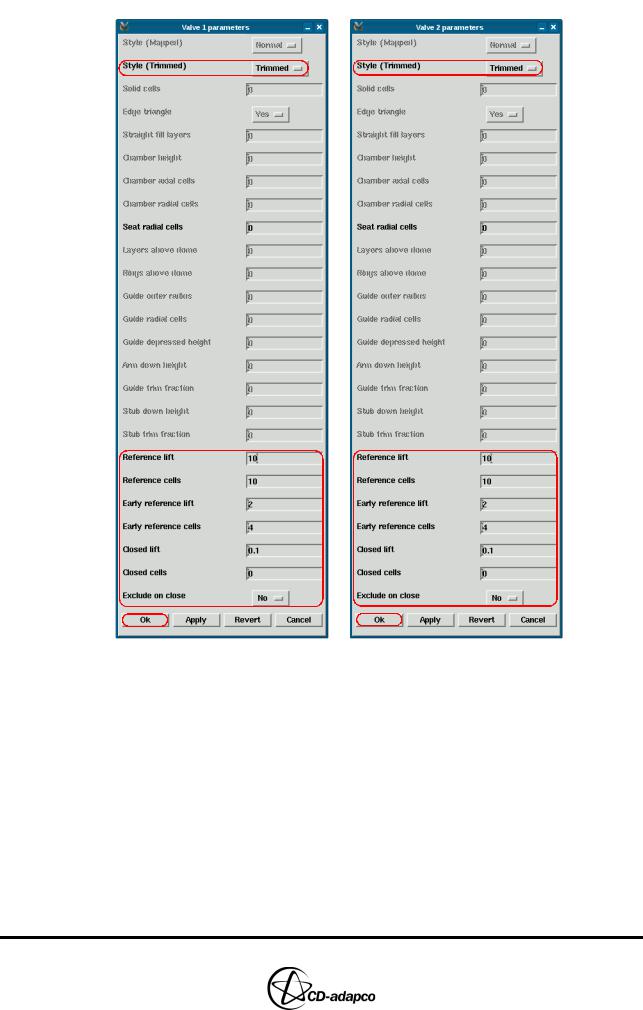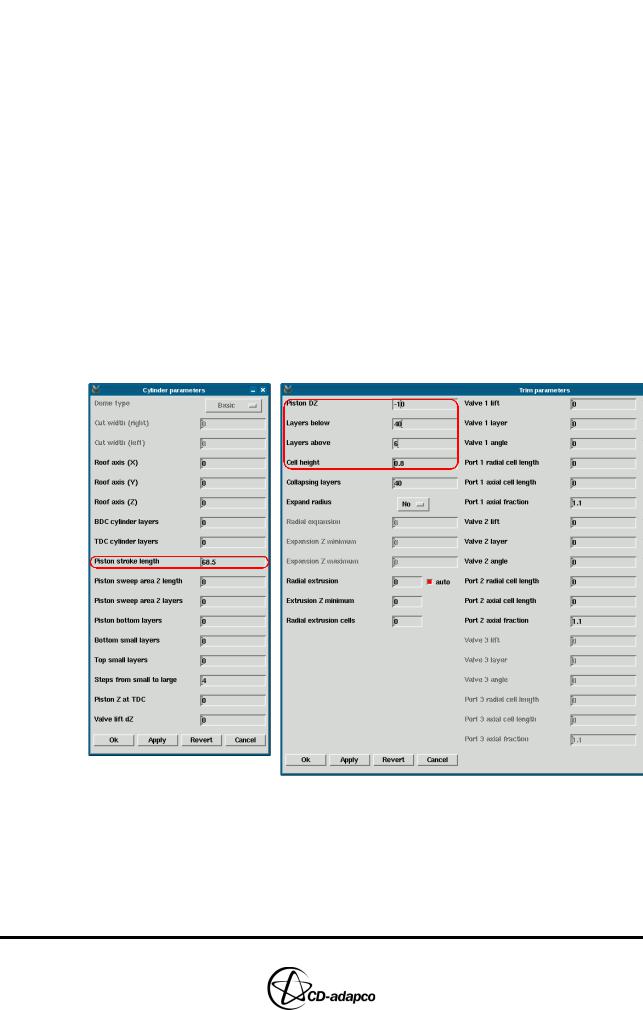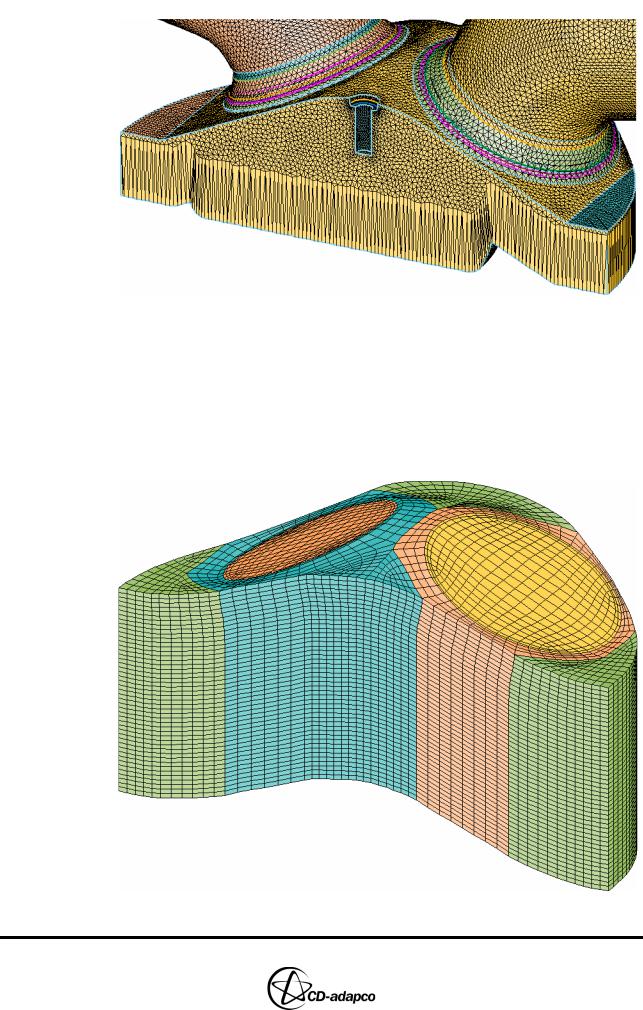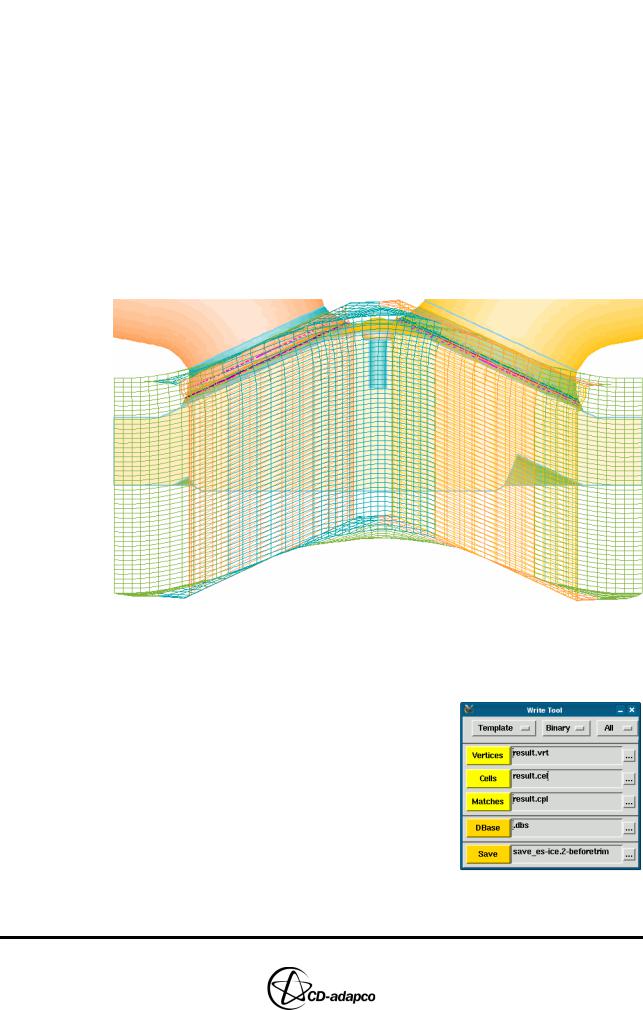
- •TABLE OF CONTENTS
- •Chapter 1 INTRODUCTION
- •The es-ice Environment
- •es-ice Meshing Capabilities
- •Tutorial Structure
- •Trimming Tutorial Overview
- •Required Files
- •Trimming Tutorial files
- •Automatic 2D Tutorial files
- •Wall Temperature Tutorial files
- •Mesh Replacement Tutorial files
- •Multiple Cylinder Tutorial files
- •Closed-Cycle Tutorial files
- •Sector Tutorial files
- •Two-Stroke Tutorial files
- •Mapping Tutorial files
- •ELSA Tutorial files
- •Chapter 2 SURFACE PREPARATION IN STAR-CCM+
- •Importing and Scaling the Geometry
- •Creating Features
- •Defining Surfaces
- •Remeshing and Exporting the Geometry
- •Chapter 3 GEOMETRY IMPORT AND VALVE WORK
- •Importing the Surfaces
- •Modelling the Valves
- •Saving the Model
- •Chapter 4 MESHING WITH THE TRIMMING METHOD
- •Modifying Special Cell Sets in the Geometry
- •Defining Flow Boundaries
- •Creating the 2D Base Template
- •Creating the 3D Template
- •Trimming the 3D Template to the Geometry
- •Improving cell connectivity
- •Assembling the Trimmed Template
- •Running Star Setup
- •Saving the Model
- •Chapter 5 CREATING AND CHECKING THE MESH
- •Chapter 6 STAR SET-UP in es-ice
- •Load Model
- •Analysis Set-up
- •Valve Lifts
- •Assembly
- •Combustion
- •Initialization
- •Cylinder
- •Port 1 and Port 2
- •Boundary Conditions
- •Cylinder
- •Port and Valve 1
- •Port and Valve 2
- •Global settings
- •Post Set-up
- •Cylinder
- •Port 1 and Port 2
- •Global settings
- •Time Step Control
- •Write Data
- •Saving the Model
- •Chapter 7 STAR SET-UP in pro-STAR
- •Using the es-ice Panel
- •Setting Solution and Output Controls
- •File Writing
- •Chapter 8 RUNNING THE STAR SOLVER
- •Running in Serial Mode
- •Running in Parallel Mode
- •Running in Parallel on Multiple Nodes
- •Running in Batch
- •Restarting the Analysis
- •Chapter 9 POST-PROCESSING: GENERAL TECHNIQUES
- •Creating Plots with the es-ice Graph Tool
- •Calculating Apparent Heat Release
- •Plotting an Indicator Diagram
- •Calculating Global Engine Quantities
- •Creating a Velocity Vector Display
- •Creating an Animation of Fuel Concentration
- •Creating an Animation of Temperature Isosurfaces
- •Chapter 10 USING THE AUTOMATIC 2D TEMPLATE
- •Importing the Geometry Surface
- •Defining Special Cell Sets in the Geometry
- •Modelling the Valves
- •Creating the Automatic 2D Template
- •Refining the 2D Template Around the Injector
- •Adding Features to the Automatic 2D Template
- •Using Detailed Automatic 2D Template Parameters
- •Saving the es-ice Model File
- •Chapter 11 MULTIPLE-CYCLE ANALYSIS
- •Setting Up Multiple Cycles in es-ice
- •Setting Up Multiple Cycles in pro-STAR
- •Chapter 12 HEAT TRANSFER ANALYSIS
- •Resuming the es-ice Model File
- •Mapping Wall Temperature
- •Exporting Wall Heat Transfer Data
- •Saving the es-ice Model File
- •Cycle-averaging Wall Heat Transfer Data
- •Post-processing Wall Heat Transfer Data in pro-STAR
- •Plotting average wall boundary temperatures
- •Plotting average heat transfer coefficients
- •Plotting average near-wall gas temperature at Y-plus=100
- •Mapping Heat Transfer Data to an Abaqus Model via STAR-CCM+
- •Chapter 13 MESH REPLACEMENT
- •Preparing the File Structure
- •Rebuilding the Dense Mesh
- •Creating Ahead Files for the Dense Mesh
- •Defining Mesh Replacements
- •Setting Up Mesh Replacement in pro-STAR
- •Setting up the coarse model
- •Setting up the dense model
- •Chapter 14 MULTIPLE CYLINDERS
- •Resuming the es-ice Model File
- •Making, Cutting and Assembling the Template
- •Setting Up Multiple Cylinders
- •Checking the Computational Mesh
- •STAR Set-Up in es-ice
- •Analysis set-up
- •Assembly
- •Combustion
- •Initialization
- •Boundary Conditions
- •Post Setup
- •Time Step Control
- •Write Data
- •Saving the es-ice Model File
- •Importing the Geometry
- •Generating the Closed-Cycle Polyhedral Mesh
- •Assigning shells to geometry cell sets
- •Specifying General, Events and Cylinder parameters
- •Creating a spray-optimised mesh zone
- •Importing a user intermediate surface
- •Checking the spray-optimised zone
- •Creating the closed-cycle polyhedral mesh
- •Running Star Setup
- •Creating and checking the computational mesh
- •Saving the Model File
- •Chapter 16 DIESEL ENGINE: SECTOR MODEL
- •Importing the Bowl Geometry
- •Defining the Bowl Shape
- •Defining the Fuel Injector
- •Creating the 2D Template
- •Creating the Sector Mesh
- •Creating and Checking the Mesh
- •Saving the Model
- •Chapter 17 DIESEL ENGINE: STAR SET-UP IN es-ice and pro-STAR
- •STAR Set-up in es-ice
- •Load model
- •Analysis setup
- •Assembly
- •Combustion
- •Initialization
- •Boundary conditions
- •Post setup
- •Time step control
- •Write data
- •Saving the Model File
- •STAR Set-up in pro-STAR
- •Using the es-ice Panel
- •Selecting Lagrangian and Liquid Film Modelling
- •Setting up the Fuel Injection Model
- •Setting up the Liquid Film Model
- •Setting up Analysis Controls
- •Writing the Geometry and Problem Files and Saving the Model
- •Chapter 18 DIESEL ENGINE: POST-PROCESSING
- •Creating a Scatter Plot
- •Creating a Spray Droplet Animation
- •Chapter 19 TWO-STROKE ENGINES
- •Importing the Geometry
- •Meshing with the Trimming Method
- •Assigning shells to geometry cell sets
- •Creating the 2D template
- •Creating the 3D template
- •Trimming the 3D template to the geometry
- •Assembling the trimmed template
- •Running Star Setup
- •Checking the mesh
- •STAR Set-up in es-ice
- •Analysis setup
- •Assembly
- •Combustion
- •Initialization
- •Boundary conditions
- •Post setup
- •Time step control
- •Write data
- •Saving the es-ice Model File
- •Chapter 20 MESHING WITH THE MAPPING METHOD
- •Creating the Stub Surface in the Geometry
- •Creating the 2D Base Template
- •Creating the 3D Template
- •General Notes About Edges and Splines
- •Creating Edges and Splines Near the Valve Seat
- •Creating the Remaining Edges and Splines
- •Creating Patches
- •The Mapping Process
- •Chapter 21 IMPROVING THE MAPPED MESH QUALITY
- •Creating Plastered Cells
- •Chapter 22 PISTON MODELING
- •Meshing the Piston with the Shape Piston Method
- •Chapter 23 ELSA SPRAY MODELLING
- •Importing the Bowl Geometry
- •Defining the Bowl Shape
- •Setting the Events and Cylinder Parameters
- •Creating the Spray Zone
- •Creating the Sector Mesh
- •STAR Set-up in es-ice
- •Load model
- •Analysis setup
- •Assembly
- •Combustion
- •Initialization
- •Boundary Conditions
- •Time step control
- •Write data
- •Saving the Model File
- •STAR Set-up in pro-STAR
- •Using the es-ice panel
- •Activating the Lagrangian model
- •Defining the ELSA scalars
- •Setting up the Lagrangian droplets
- •Defining boundary regions and boundary conditions
- •Setting up analysis controls
- •Adding extended data for the ELSA model
- •Writing the Geometry and Problem Files and Saving the Model

Chapter 4 |
MESHING WITH THE TRIMMING METHOD |
|
Creating the 3D Template |
|
|
Creating the 3D Template
Now that the 2D template has been created, you can adjust the remaining parameters in the third template dimension using the Create Template panel. Note that, in general, a value of “0” in the parameter boxes means that es-ice will calculate a default value. It is recommended that you initially use as many parameter defaults as possible.
By looking at the Valve 1 lift file (vlift01.dat), you can see that the maximum valve lift is close to 9.4 millimetres. The aim of this tutorial is to achieve a cell spacing of 1 millimetre at maximum valve lift. This consideration will therefore determine some of the settings you will apply to the model in the following steps (see Chapter 4, “The Valve parameters panel” in the User Guide for more information on valve parameters). Note that when modeling valves using the trimming method many of these parameters are not required.
To define the valve parameters:
•In the Create Template panel, select Valve 1 from the Valves drop-down menu
•In the Valve 1 parameters panel (see Figure 4-25), ensure Style (Trimmed) is set to Trimmed
•Set Reference lift to 10
•Set Reference cells to 10
•es-ice aims to maintain the vertical cell spacing in the valve curtain equal to the Reference lift divided by the Reference cells. Therefore, the above parameters will give a cell spacing of approximately 1 millimetre
•Ensure that Early reference lift is set to 2
•Ensure that Early reference cells is set to 4
•These parameters result in a finer mesh for low valve lifts, as es-ice aims to create four cells when the valve is open by 2 millimetres. This setting gives a cell spacing of approximately 0.5 millimetres at low valve lift.
•Ensure that Closed lift is set to 0.1
•This parameter is the valve lift at which the STAR solver considers the valve as closed, which will then avoid a large pressure difference across a small area.
•In addition, this distance allows room for two extrusion layers (on the valve face and on the valve seat) and one Closed cell layer when the valve is closed. You will apply a full extrusion layer at a later stage.
•Ensure Exclude on close is set to No
•Accept the remaining default values and click Ok
•Repeat these settings for Valve 2, as shown in Figure 4-25
Version 4.20 |
4-19 |

MESHING WITH THE TRIMMING METHOD |
Chapter 4 |
Creating the 3D Template |
|
|
|
Figure 4-25 3D parameters for Valves 1 and 2 (see also Figure 4-25 in the User Guide)
The final stage in creating the 3D template is to define the Cylinder and Trim parameters. As part of this process, you will set the Piston DZ parameter to move the piston automatically by a specified amount before trimming. Recall that the piston is currently at the TDC position, but template trimming requires you to move the piston down a few millimetres. This increased clearance allows enough space for the mesher to add several deletion layers between the dome and the piston. If the piston does not move by the specified amount, it is probably because you have not set Geometry CSet 2 correctly.
To set the Cylinder and Trim parameters:
•In the Create Template panel, click Cylinder
•In the Cylinder parameters panel (see Figure 4-26), set the Piston stroke length to 68.5
4-20 |
Version 4.20 |

Chapter 4 |
MESHING WITH THE TRIMMING METHOD |
|
Creating the 3D Template |
|
|
•Accept the remaining default parameters and click Ok
•In the Create Template panel (see Figure 4-26), click Trim
•In the Trim parameters panel set Piston DZ to -10; this is a good starting value for most cases
•Set Layers below to 40
•Set Layers above to 6
•Adjust these parameters so that the generated 3D template covers the piston, the dome and the valve seat. An example of the result of this adjustment is shown in Figure 4-29.
•Note that entering large parameter values guarantees that the template covers the geometry. However, this practice is not recommended because it increases the size of the es-ice model file.
•Set Cell height to 0.8
•This setting ensures that the template cell layers are created with a height of approximately 1 millimetre. This is very close to the cell height in the valve curtain, as previously defined.
•Accept the remaining default parameters and click Ok
Figure 4-26 Modified cylinder and trim parameters
Figure 4-27 shows that the piston has moved down by 10 millimetres.
Version 4.20 |
4-21 |

MESHING WITH THE TRIMMING METHOD |
Chapter 4 |
Creating the 3D Template |
|
|
|
Figure 4-27 Piston moved down by 10 mm (Piston DZ parameter - Trim Parameters panel)
After all parameters have been set:
•In the Create Template panel, click Make Template to create the template and write its data to a file with default name save_ice
•Click Read Template to read the 3D template into the current working session and plot it in the Template window, as shown in Figure 4-28
Figure 4-28 Template window: 3D template for trimming
4-22 |
Version 4.20 |

Chapter 4 |
MESHING WITH THE TRIMMING METHOD |
|
Creating the 3D Template |
|
|
Note that new local coordinate systems are created for the valves (with coordinate system IDs 13 and 14). These systems are repositioned to the bottom of the closed valves and rotated to θ = 0.
Finally, create a double-plot of the template over the geometry surface to check that enough cell layers are included to generate a trimmed template.
•In the Plot Tool, select Geometry from the drop-down menu to activate the
Geometry window
•Collect all geometry cells into the current cell set
•Deselect the Mesh toggle button
•Select Template from the drop-down menu to activate the Template window
•Deselect the Fill toggle button
•Set Views to 0, -1, 0
•Click DPlot to display the template on top of the geometry surface, as shown in Figure 4-29.
Figure 4-29 Template window: Overlay of template and geometry
It is recommended that you save your work up to this point by writing the current model data into a new save_es-ice file.
•In the Write Tool, enter save_es-ice.2-beforetrim and click
Save
Version 4.20 |
4-23 |
